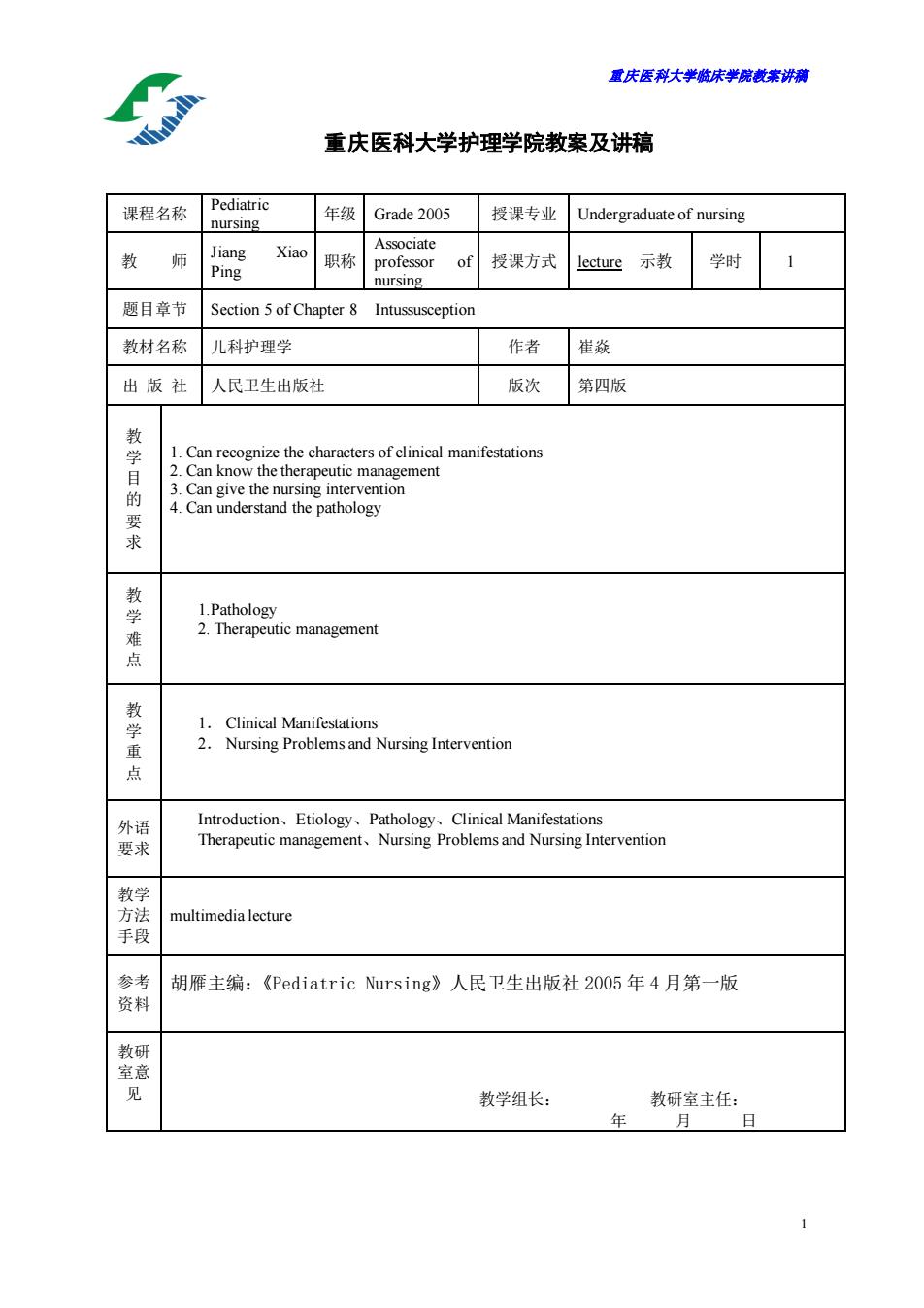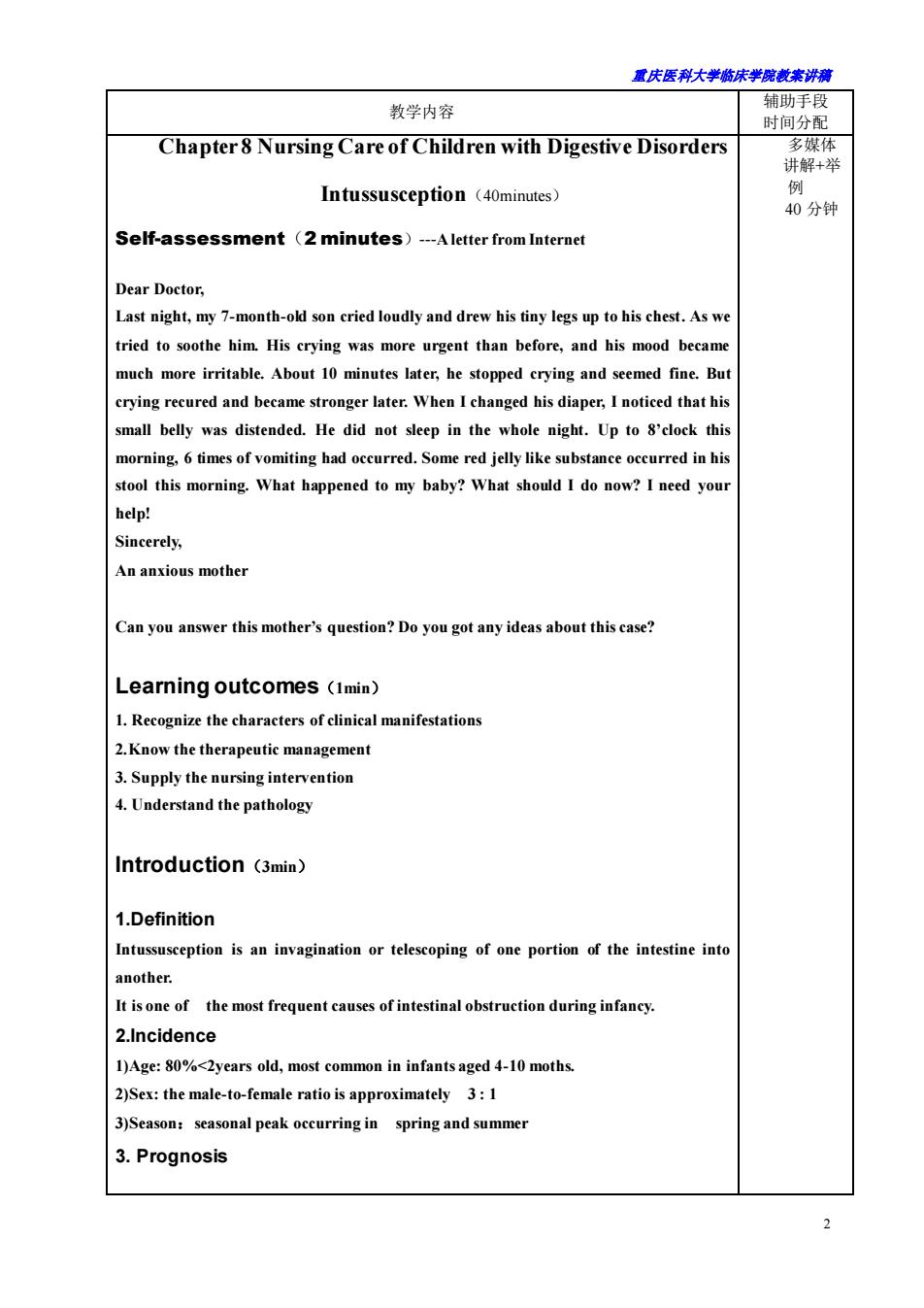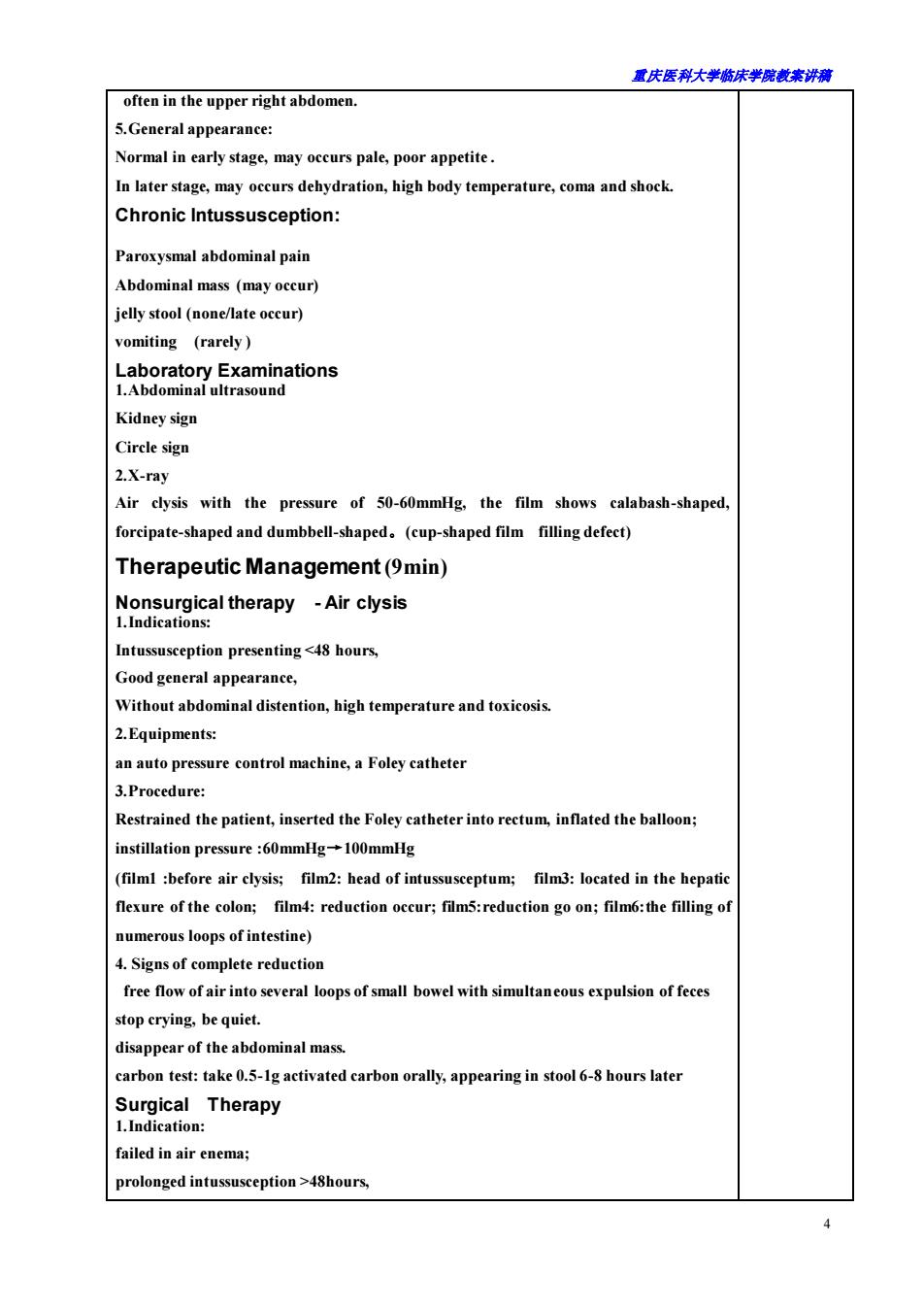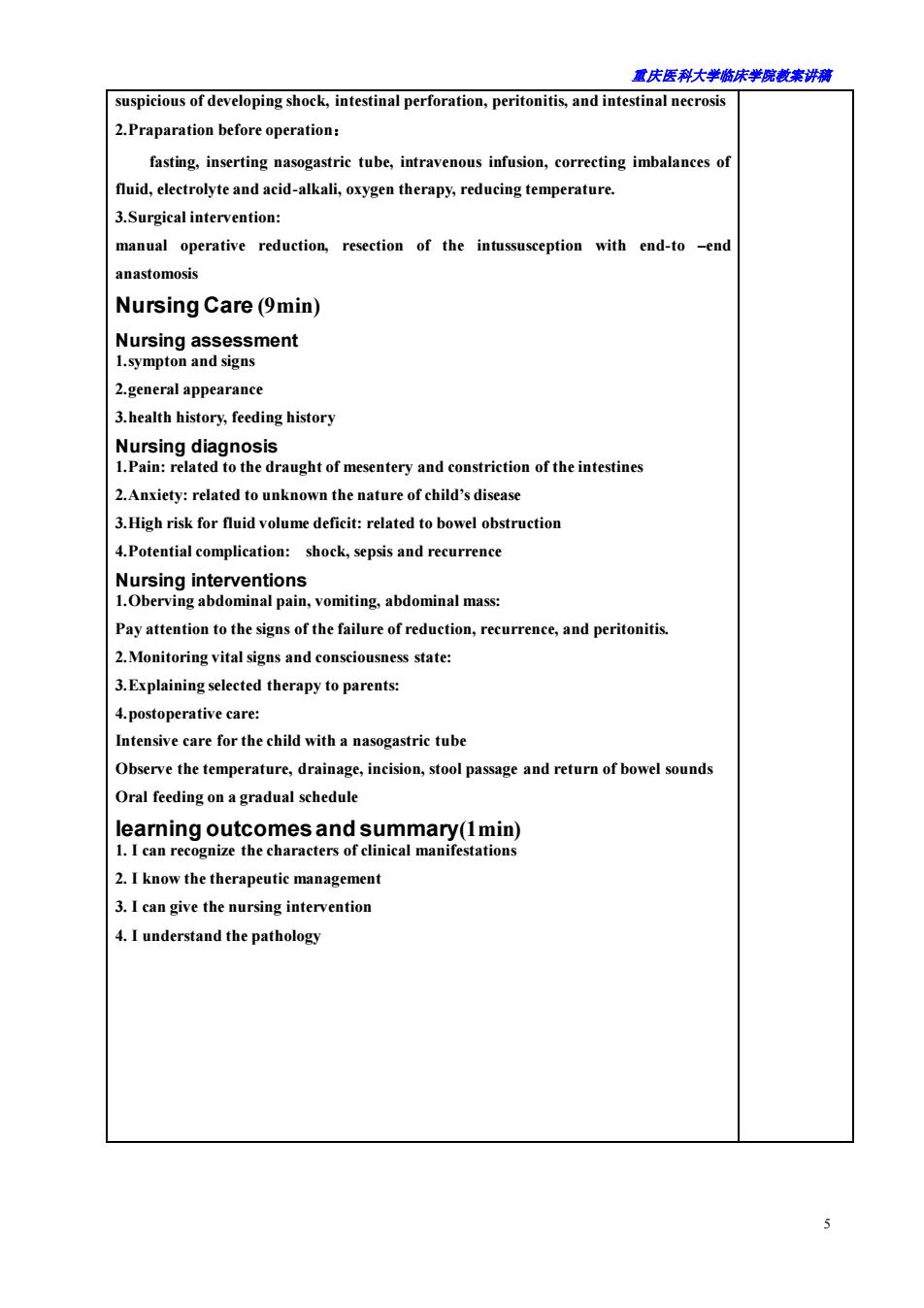
置庆医科大学脑床学院款未讲满 重庆医科大学护理学院教案及讲稿 课和名称 年级Grade20o5授课专业Undergraduate of nursing Xiao职称 授课方式lecture nursing 示教学时 1 题目章节Section5 of Chapter8 Intussusception 教材名称儿科护理学 作者崔焱 出版社人民卫生出版社 版次 第四版 的 求 难点 教学重点 1.Clinical Manifestations 2.Nursing Problems and Nursing Intervention multimedialecture 手段 参考 胡雁主编:《Pediatric Nursing》人民卫生出版社2005年4月第一版 资料 见 教学组长: 教研室主任: 月 日
重庆医科大学临床学院教案讲稿 1 重庆医科大学护理学院教案及讲稿 课程名称 Pediatric nursing 年级 Grade 2005 授课专业 Undergraduate of nursing 教 师 Jiang Xiao Ping 职称 Associate professor of nursing 授课方式 lecture 示教 学时 1 题目章节 Section 5 of Chapter 8 Intussusception 教材名称 儿科护理学 作者 崔焱 出 版 社 人民卫生出版社 版次 第四版 教 学 目 的 要 求 1. Can recognize the characters of clinical manifestations 2. Can know the therapeutic management 3. Can give the nursing intervention 4. Can understand the pathology 教 学 难 点 1.Pathology 2. Therapeutic management 教 学 重 点 1. Clinical Manifestations 2. Nursing Problems and Nursing Intervention 外语 要求 Introduction、Etiology、Pathology、Clinical Manifestations Therapeutic management、Nursing Problems and Nursing Intervention 教学 方法 手段 multimedia lecture 参考 资料 胡雁主编:《Pediatric Nursing》人民卫生出版社 2005 年 4 月第一版 教研 室意 见 教学组长: 教研室主任: 年 月 日

露庆医科大学临床半院载案讲满 教学内容 辅助手段 时间分配 Chapter 8 Nursing Care of Children with Digestive Disorders 多媒体 讲解+举 Intussusception (40minutes) 40分钟 Self-assessment(2 minutes)-Aletter from Internet Dear Doctor. Last night,my 7-month-od loudly and drew his tiny legs up to his chest.As we tried to soothe him.His erying was more urgent than before,and his mood became much more irritable.About 10 minutes later,he stopped crying and seemed fine.Bu crying recured and became stronger later.When I changed his diaper,I noticed that his small belly was distended.He did not sleep in the whole night.Up to 8'clock this morning,6 times of vomiting had occurred.Some red jelly like substance occurred in his stool this morning.What happened to my baby?What should I do now?I need your help! Sincerely, An anxious mother Can you answer this mother's question?Do you got any ideas about this case? Learning outcomes (1min) 1.Recognize the characters of clinical manifestations 2.Know the therapeutic management 3.Supply the nursing intervention 4.Understand the pathology Introduction (3min) 1.Definition Intussusception is an invagination or telescoping of one portion of the intestine int another. It isone of the most frequent causes of intestinal obstruction during infancy. 2.Incidence 1)Age:80%2years old,most common in infants aged 4-10 moths. 2)Sex:the male-to-female ratio is approximately 3:1 3)Season:seasonal peak occurring in spring and summer 3.Prognosis 2
重庆医科大学临床学院教案讲稿 2 教学内容 辅助手段 时间分配 Chapter 8 Nursing Care of Children with Digestive Disorders Intussusception(40minutes) Self-assessment(2 minutes)-A letter from Internet Dear Doctor, Last night, my 7-month-old son cried loudly and drew his tiny legs up to his chest. As we tried to soothe him. His crying was more urgent than before, and his mood became much more irritable. About 10 minutes later, he stopped crying and seemed fine. But crying recured and became stronger later. When I changed his diaper, I noticed that his small belly was distended. He did not sleep in the whole night. Up to 8’clock this morning, 6 times of vomiting had occurred. Some red jelly like substance occurred in his stool this morning. What happened to my baby? What should I do now? I need your help! Sincerely, An anxious mother Can you answer this mother’s question? Do you got any ideas about this case? Learning outcomes(1min) 1. Recognize the characters of clinical manifestations 2.Know the therapeutic management 3. Supply the nursing intervention 4. Understand the pathology Introduction(3min) 1.Definition Intussusception is an invagination or telescoping of one portion of the intestine into another. It is one of the most frequent causes of intestinal obstruction during infancy. 2.Incidence 1)Age: 80%<2years old, most common in infants aged 4-10 moths. 2)Sex: the male-to-female ratio is approximately 3 : 1 3)Season:seasonal peak occurring in spring and summer 3. Prognosis 多媒体 讲解+举 例 40 分钟

置庆医科大学脑床半院载未讲满 The earlier diagnosis and treatment,the better prognosis.Most cases can treat with on-surgical therapy,but some severe late period cases should take operation. Comparing with the 50 of last century,the mortality has decreased from 20-30%to 0.1%。 Etiology (3min) 1.Primary:95%,but the cause is unknown. May correlation with more mobility and less fixation ofintestinal mesentery 2.Secondary:5%,related to intestinal polypi or tumors 3.Predisposing factors: caused by disorder of the intestinal peristalsis,such as Diseases:gastroenteritis,diarrhea.fever,et al Dietary alteration:complementary solid food Virus infections:adenovirus,rotaviruses,reoviruses,echoviruses Pathology (3min) the proximal portion of bowel (intussusceptum) the adjacent distal bowel (intussuscipiens) The mesentery of the intussusceptum is compressed The ensuing swelling of the bowel wall quickly leads to obstruction. Venous engorgement and ischemia of the intestinal mucosa cause bleeding and an outpouring of mucous,which results in the classic description of red currant jelly stool Clinical Manifestation (10min) Acute abdominal pain in sudden onset:loud cries,screaming and drawing the knees up to the chest. Appears normal and comfortable at the interval time. Onset and interval occurs regularly Caused by draught of mesentery and constriction of the intestines. 2.Vomiting: Occurs in most cases,>90%.more frequent at early stage In the later stage,the vomitus becomes bile stained or stool liquid,demonstrates obstruction of intestines. 3.Bloodystool: A very important symptom,occurs in the first 6 to 12 hours Stool containing red blood and mucus,jelly stool Rectal examination shows bloody mucus on the finger 4.Abdominal mass: slightly tender sausage-shaped mass
重庆医科大学临床学院教案讲稿 3 The earlier diagnosis and treatment, the better prognosis. Most cases can treat with non-surgical therapy, but some severe late period cases should take operation. Comparing with the 50th of last century, the mortality has decreased from 20-30% to 0.1%。 Etiology (3min) 1.Primary: 95%,but the cause is unknown. May correlation with more mobility and less fixation of intestinal mesentery 2.Secondary: 5%,related to intestinal polypi or tumors 3.Predisposing factors: caused by disorder of the intestinal peristalsis, such as Diseases: gastroenteritis, diarrhea, fever, et al Dietary alteration: complementary solid food Virus infections: adenovirus, rotaviruses, reoviruses, echoviruses Pathology (3min) the proximal portion of bowel (intussusceptum) the adjacent distal bowel (intussuscipiens) The mesentery of the intussusceptum is compressed The ensuing swelling of the bowel wall quickly leads to obstruction. Venous engorgement and ischemia of the intestinal mucosa cause bleeding and an outpouring of mucous, which results in the classic description of red currant jelly stool Clinical Manifestation (10min) Acute intussusception 1.Abdominal pain Acute abdominal pain in sudden onset: loud cries, screaming and drawing the knees up to the chest. Appears normal and comfortable at the interval time. Onset and interval occurs regularly Caused by draught of mesentery and constriction of the intestines. 2.Vomiting: Occurs in most cases, >90%, more frequent at early stage. In the later stage, the vomitus becomes bile stained or stool liquid, demonstrates obstruction of intestines. 3.Bloody stool: A very important symptom, occurs in the first 6 to 12 hours. Stool containing red blood and mucus, jelly stool Rectal examination shows bloody mucus on the finger 4.Abdominal mass: a slightly tender sausage-shaped mass

君庆医科大学临床半院表来讲满 often in the upper right abdomen. 5.General appearance: Normal in early stage,may occurs pale,poor appetite. In later stage,may occurs dehydration,high body temperature,coma and shock. Chronic Intussusception: Paroxysmal abdominal pain Abdominal mass (may occur) ielly stool (none/late occur) vomiting (rarely) Kidneysign Circle sign 2.X-ray Air clysis with the pressure of 50-60mmHg,the film shows calabash-shaped, forcipate-shaped and dumbbell-shaped.(cup-shaped film filling defect) Therapeutic Management(9min) hrapyAir c Intussusception presenting<4 hours, Good general appearance, Without abdominal distention,high temperature and toxicosis 2.Equipments: an auto pressure control machine,a Foley catheter 3.Procedure: Restrained the patient,inserted the Foley catheter into rectum,inflated the balloon: nstillation pressure :60mmHg-100mmHg (filml :before air clysis;film2:head of intussusceptum;film3:located in the hepatic exure of the colon;film:reduction occur;fim5:reduction go on;film6:the filling of umerous loops of intestine) 4.Signs of complete reduction free flow of air into several loops of small bowel with simultaneous expulsion of feces stop crving,be quiet. disappear of the abdominal mass carbon test:take 0.5-1g activated carbon orally,appearing in stool 6-8 hours later ion: failed in air enema: prolonged intussusception>4hours
重庆医科大学临床学院教案讲稿 4 often in the upper right abdomen. 5.General appearance: Normal in early stage, may occurs pale, poor appetite . In later stage, may occurs dehydration, high body temperature, coma and shock. Chronic Intussusception: Paroxysmal abdominal pain Abdominal mass (may occur) jelly stool (none/late occur) vomiting (rarely ) Laboratory Examinations 1.Abdominal ultrasound Kidney sign Circle sign 2.X-ray Air clysis with the pressure of 50-60mmHg, the film shows calabash-shaped, forcipate-shaped and dumbbell-shaped。(cup-shaped film filling defect) Therapeutic Management (9min) Nonsurgical therapy - Air clysis 1.Indications: Intussusception presenting <48 hours, Good general appearance, Without abdominal distention, high temperature and toxicosis. 2.Equipments: an auto pressure control machine, a Foley catheter 3.Procedure: Restrained the patient, inserted the Foley catheter into rectum, inflated the balloon; instillation pressure :60mmHg→100mmHg (film1 :before air clysis; film2: head of intussusceptum; film3: located in the hepatic flexure of the colon; film4: reduction occur; film5:reduction go on; film6:the filling of numerous loops of intestine) 4. Signs of complete reduction free flow of air into several loops of small bowel with simultaneous expulsion of feces stop crying, be quiet. disappear of the abdominal mass. carbon test: take 0.5-1g activated carbon orally, appearing in stool 6-8 hours later Surgical Therapy 1.Indication: failed in air enema; prolonged intussusception >48hours

重庆医科大学脑床半院载未讲满 suspicious of developing shock,intestinal perforation,peritonitis,and intestinal necrosis 2.Praparation before operation fasting,inserting nasogastric tube,intravenous infusion,correcting imbalanceso fluid,electrolyte and acid-alkali,oxygen therapy,reducing temperature. 3.Surgical intervention: manual operative reduction,resection of the intussusception with end-to -end Nursing Care(9min) 2.general appearance 3.health history,feeding history Nursing diagnosis 1.Pain:related to the draught of mesentery and constriction of the intestines 2.Anxiety:related to unknown the nature of child's disease 3.High risk for fluid volume deficit:related to bowel obstruction 4.Potential complication: shock,sepsis and recurrence Nursina interventions 1.Oberving abdominal pain,vomiting,abdominal mass: Pay signs of the failure of reduction,peritonitis 2.Monitoring vital signs and consciousness state: 3.Explaining selected therapy to parents: 4.postoperative care: ntensive care for the child with a nasogastric tube Observe the temperature,drainage.incision.stool passage and return of bowel sounds Oral feeding on a gradual schedul leamingoutsoamesandsumrmaYlme 2.I know the therapeutic management 3.I can give the nursing intervention 4.I understand the pathology
重庆医科大学临床学院教案讲稿 5 suspicious of developing shock, intestinal perforation, peritonitis, and intestinal necrosis 2.Praparation before operation: fasting, inserting nasogastric tube, intravenous infusion, correcting imbalances of fluid, electrolyte and acid-alkali, oxygen therapy, reducing temperature. 3.Surgical intervention: manual operative reduction, resection of the intussusception with end-to –end anastomosis Nursing Care (9min) Nursing assessment 1.sympton and signs 2.general appearance 3.health history, feeding history Nursing diagnosis 1.Pain: related to the draught of mesentery and constriction of the intestines 2.Anxiety: related to unknown the nature of child’s disease 3.High risk for fluid volume deficit: related to bowel obstruction 4.Potential complication: shock, sepsis and recurrence Nursing interventions 1.Oberving abdominal pain, vomiting, abdominal mass: Pay attention to the signs of the failure of reduction, recurrence, and peritonitis. 2.Monitoring vital signs and consciousness state: 3.Explaining selected therapy to parents: 4.postoperative care: Intensive care for the child with a nasogastric tube Observe the temperature, drainage, incision, stool passage and return of bowel sounds Oral feeding on a gradual schedule learning outcomes and summary(1min) 1. I can recognize the characters of clinical manifestations 2. I know the therapeutic management 3. I can give the nursing intervention 4. I understand the pathology